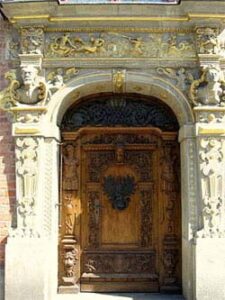The “Golden House”, Langmarket, Gdansk, Prussia
“Danzig (Gdansk) originally owed its commercial importance to the fact that it was the shipping port for the corn grown in Poland and the adjacent regions of Russia and Prussia. Brothers, William and Peter Pickering were wealthy corn merchants in Cheshire, England and joined the Steffens family through the convenient business marriages to two Steffens daughters.”
 As I was researching our association with the Steffens family of Danzig, I was thrilled to run across a copy of the National Geographic of 1939, which published a fascinating story entitled “Historic Danzig: Last of the City-States” by William and Alicelia Franklin. The article described the homes of the wealthy merchants that lived on the famous Long Market of Danzig. I have included a link to this issue of National Geographic. Please be patient, it is a large file but well worth waiting for. Page 681 describes those who owned “three window” homes on the market and page 685 shows a wonderful photo of the Steffens home.
As I was researching our association with the Steffens family of Danzig, I was thrilled to run across a copy of the National Geographic of 1939, which published a fascinating story entitled “Historic Danzig: Last of the City-States” by William and Alicelia Franklin. The article described the homes of the wealthy merchants that lived on the famous Long Market of Danzig. I have included a link to this issue of National Geographic. Please be patient, it is a large file but well worth waiting for. Page 681 describes those who owned “three window” homes on the market and page 685 shows a wonderful photo of the Steffens home.

The Steffens House is considered one of the most beautiful patrician houses on Long Market (no. 41). Contrary to its name, the building is not really made of gold but much of the front elevation of the 400 year old house was adorned with gold.
The Renaissance building commissioned by the rich corn merchant Hans Speymann acquired its nickname “Golden House” (Zlota Kamienica) due to the rich gold decoration applied by the Rostock artist Hans Voigt. The house, later occupied by my ancestors – the Steffens family – can be easily identified by the four figures mounted on the roof.
Long Market ends in the direction of the river Motlawa at the Green Gate (Zielona Brama) built in the style of the Flemish Renaissance. It used to be a residence for Polish kings visiting Gdansk and was originally painted green, today you can find the office of Poland’s former president Lech Walesa here.
 The Golden House, also known as Speimann House or Steffens House is one of the most beautiful buildings in Gdansk. It was erected in 1609 by Jan Speyman, the Mayor of the city and at the same time a wealthy merchant and an open-minded patron of the arts, and his wife, Judyta (from the Bahra family).
The Golden House, also known as Speimann House or Steffens House is one of the most beautiful buildings in Gdansk. It was erected in 1609 by Jan Speyman, the Mayor of the city and at the same time a wealthy merchant and an open-minded patron of the arts, and his wife, Judyta (from the Bahra family).
The construction was based on a design prepared by Abraham van den Blocke, who was also responsible for a part of the sculptural decorations which were completed in 1618. The house is famous for its richly-decorated facade. Local people claim that it is haunted. The legend goes that from time to time the corridors of the house are frequented by a luminous creature. It is a ghost of the beautiful Judyta Speymann whispering “A just deed fears no man”. Today the building houses the Maritime Institute. [Ref: GdanskAdventure.com]
 The four statues on top the Golden House are Cleopatra, Oedipus, Achilles, and Antigone. The creator of the polychrome sculptures and bas reliefs was Jan Voigt.
The four statues on top the Golden House are Cleopatra, Oedipus, Achilles, and Antigone. The creator of the polychrome sculptures and bas reliefs was Jan Voigt.
During WWII the beautiful buildings of Dangiz were laid to ruin however the Golden House was rebuilt from the remaining facade.

